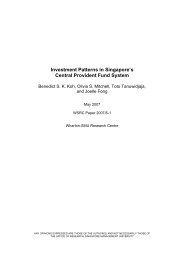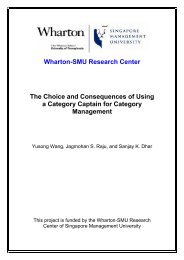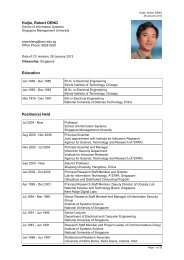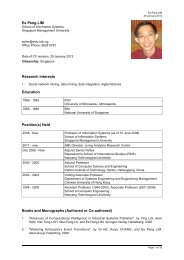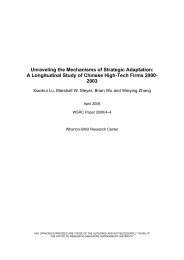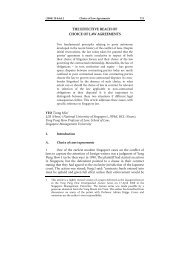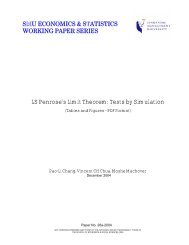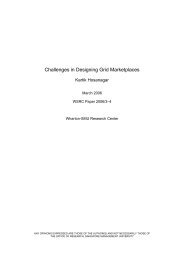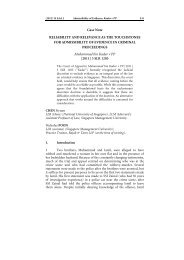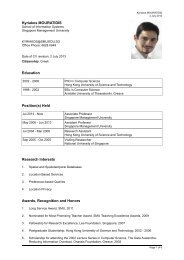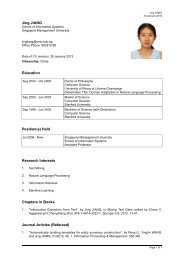The Benefits of Volume-Conditional Order-Crossing - Singapore ...
The Benefits of Volume-Conditional Order-Crossing - Singapore ...
The Benefits of Volume-Conditional Order-Crossing - Singapore ...
Create successful ePaper yourself
Turn your PDF publications into a flip-book with our unique Google optimized e-Paper software.
elative imbalance between buy and sell orders. This makes the conditional market more attractive<br />
to patient hedgers, whose presence is necessary for this market to clear. 18 This is yet another role<br />
played by the volume condition in the trading venue proposed in this paper.<br />
4.3 Equilibrium, Welfare and Price Discovery<br />
<strong>The</strong> effect <strong>of</strong> adding a conditional market on the equilibrium <strong>of</strong> Proposition 4.1 depends on whether<br />
the informed traders use or are excluded from the continuous market when it operates by itself,<br />
that is, it depends on whether p ≥ 2κ<br />
λ<br />
2κ or p < λ . In the former case, adding the conditional market<br />
has a similar effect as in Proposition 3.2: with a high-enough volume condition, impatient hedgers<br />
and informed traders do not find this new trading venue attractive and keep using the continuous<br />
market for their trades; patient hedgers can therefore use the conditional market to hedge their<br />
wealth shocks at least a fraction <strong>of</strong> the time; in turn, the revenues that the market-maker generates<br />
from the conditional market allow him to reduce the ask price in the continuous market. When<br />
p < 2κ<br />
λ , the conditional market must accommodate both patient hedgers and informed traders. As<br />
the analysis <strong>of</strong> section 4.2 shows, the conditional market allows these traders to coexist and trade<br />
(with some probability) as long as the adverse selection brought about by the informed traders<br />
is not too severe. Again, the volume condition <strong>of</strong> the conditional market plays a crucial role: it<br />
ensures that the adverse selection cost that the patient hedgers must absorb is low enough that<br />
they find it worthwhile to use the conditional market. Also, the extra revenues from the conditional<br />
market allow the market-maker to reduce the continuous market’s ask price.<br />
Proposition 4.2 As long as<br />
(i) p ≥ 2κ<br />
λ , or<br />
(ii) p < 2κ<br />
λ<br />
and (14) holds,<br />
there always exists an equilibrium in which the presence <strong>of</strong> the conditional market makes every trader<br />
in the economy at least as well-<strong>of</strong>f and some traders (strictly) better <strong>of</strong>f than when the continuous<br />
market operates alone.<br />
As in section 3.3, the volume condition keeps the impatient hedgers in the continuous market.<br />
With informed traders in the economy, this condition does more. It can be used to ensure that<br />
there is a sufficient number <strong>of</strong> patient hedgers in the conditional market when this market clears.<br />
Without the volume condition, patient hedgers anticipate the presence <strong>of</strong> informed traders in the<br />
18<br />
Notice that the presence <strong>of</strong> informed traders in the conditional market does not facilitate market clearing. Indeed,<br />
without them, there is an equal number ˜m(1−λ)<br />
<strong>of</strong> patient hedgers on both sides <strong>of</strong> the market, and the market clears<br />
2<br />
if and only if ˜m(1−λ)<br />
≥ ψ, as before.<br />
2<br />
19



